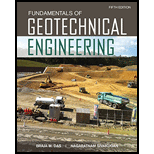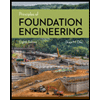
(a)
Whether the statement “A key is provided at the base of a cantilever retaining wall to improve the stability with respect to overturning” is true or false.
(a)
Answer to Problem 15.1P
The given statement is
Explanation of Solution
Actually a key is provided to increase the passive resistance at the toe which will increase the factor of safety against sliding. Hence, the base key will improve the stability of wall with respect to sliding.
Therefore, the given statement is
(b)
Whether the statement “The earth pressure distribution beneath the base of the retaining wall is uniform” is true or false.
(b)
Answer to Problem 15.1P
The given statement is
Explanation of Solution
The distribution of earth pressure below the base slab is not uniform because,
- Different earth pressure exerts on the base slab.
- The base slab is not a homogeneous one (concrete has homogeneous property).
- The friction between soil and base slab can distribute the earth pressure that is non-uniform in nature.
Therefore, the given statement is
(c)
Whether the statement “The lateral earth pressures in active state are greater in loose sands than in dense sands” is true or false.
(c)
Answer to Problem 15.1P
The given statement is
Explanation of Solution
- Active lateral earth pressure is the tilting of wall away from the position.
- The chance of tilting is more in loose sands compared to dense sands. Hence, the lateral earth pressures in active state are greater in loose sands than in dense sands.
Therefore, the given statement is
(d)
Whether the statement “A base heave problem is more serious in soft clays than in stiff clays” is true or false.
(d)
Answer to Problem 15.1P
The given statement is
Explanation of Solution
- Braced cuts in clay may become unstable due to the formation of heaving at the bottom of the excavation.
- Heave is the upward movement of the ground due to the expansion of clay, which swells when wet.
- More expansion will lead to heave. The expansion of soft clay is more compared to stiff clay. Hence, the base heave problem is more serious in soft clays than in stiff clays.
Therefore, the given statement is
(e)
Whether the statement “Cantilever sheet piles have to be driven deeper in loose sands than in dense sands” is true or false.
(e)
Answer to Problem 15.1P
The given statement is
Explanation of Solution
- The reason to drive sheet piles at a certain depth below the bottom excavation is to reduce the lateral yielding of wall during the last stages of excavation.
- The lateral yielding in the loose sands is greater than the dense sands. Hence, the cantilever sheet piles have to be driven deeper in loose sands than in dense sands. The deeper piles will reduce the lateral yielding.
Therefore, the given statement is
Want to see more full solutions like this?
Chapter 15 Solutions
Fundamentals of Geotechnical Engineering (MindTap Course List)
- A borehole. A clay layer is discovered 7m below a sandy soil. The groundwater table of the area is 10m below the natural grade line. The sandy soil has a unit weight of the clay layer is 22.3 kn/m3 , and the moisture content and specific gravity is 12.4% and 2.7, respectively. A. Find the driend unit weight of the clay layer B. Find the total stress on a point 13m below the natural grade line. C. The effective stress at a point 10m below the grade line. D. Find the effective stress 13m below the natural grade line if there is a ground water drawdown of 4.5m due to groundwater extractionarrow_forwardQ-A hollow rectangular masonry pier 600 mm x 900 mm and 150 mm thick transmits a vertical load of 500 KN in a vertical plane bisecting the 900 mm side and at an eccentricity of 100 mm from the geometrical axes of the section. Determine the maximum and minimum stress intensity in the section.arrow_forwardQ-f Calculate the settlement of the bridge pier shown in Fig. Q-f (page 3) due to primary consolidation of the clay. The bridge load imposes an approximate vertical stress increase at the center of the clay layer of 150 kPa. 9 m 1 m 1 m 12 MN Pier: 3 m x 10 m 3 m 5 m Dense sand e = 0.45 E' = 55 MPa v' = 0.35 $' = 36° Normally consolidated clay eo = 0.85 E' = 15 MPa Sand and gravel Cc = 0.3 (su) f = 40 kPa v' = 0.25, vμ = 0.45 c = 30°arrow_forward
- The following figure shows a section of an anchored retaining wall embedded into a saturated stiff clay layer. The sand has a unit weight of = 18 kN/m³, c' = 0 kPa and o' = 34º. The clay has a unit weight of = 20 kN/m³, c₁ = 80 kPa and = 0°. A uniform pressure of 40 kPa is applied on the soil surface. The short term stability of the wall is considered in an undrained analysis. Use the Rankin's theory of lateral earth pressure to determine the active and passive horizontal stresses. You should apply the requirements of AS 4678 and the partial factors of safety method in estimation of soil pressures. Assume the soil is in-situ and use a structural classification factor of ₁ = 1. 3m 1m Water table 1.5m 40 kPa Not to Scale Sand Clay Taarrow_forwardThe footing shown in Figure (1) carries (24 columns) spaced at (5 m) center to center. The vertical load and overturning moment on each column are (850 kN) and (340 kN.m), respectively. Calculate: A. The safety factor against soil shear failure. B. The settlement below the centerline due to the elastic deformation of the first layer. C. The maximum consolidation settlement. 0.5 Section A-A 0.5 mt 6.0 m ) 4.0 m A A Silty Sand Sand Silty Clay Plan 850 V 3 m 340 M 3 y = 18 kN/m³, c = 0, p=30° Gs=2.7, v=0.3, Es = 10 MPa y = 19 kN/m³, L.L=0.3, Gs=2.8 Y = 18 kN/m³ Fig.1 W.T 0.5arrow_forwardThe proposed building will exert a net stress of 12 Newtons per square centimeter. a) Determine the buoyant unit weight of the clay b) Determine the effective vertical stress at the mid-height of the clay layer c) Determine the average settlement of the normally consolidated clay layer. Use compression index C = 0.009(LL - 10)arrow_forward
- Determine the stability of the cantilever gravity retaining wall shown in figure below. The existing soil is a clay and the backfill is a coarse-grained soil. The base of the wall will rest on a 50-mm-thick, compacted layer of the backfill. The interface friction between the base and the compacted layer of backfill is 25.0°. Groundwater level is 8 m below the base. 1.0 m Batter 1:20 0.4 m 1.8 m 9, = 20 kPa 8⁰ Ysat = 18 kN/m³ cs = 25° 8 = 15⁰ Backfill Drainage blanket Y = 23.5 kN/m³ 3 m Existing soil 6.1 m 0.9 mi Ysat = 19 kN/m³ = 35° % = 25°arrow_forward1. Given the soil profile below, determine the Total Stress and Effective Stress at points A, B, C, and D. CL 5ft y = 102 Ib/ft3 A • 9ft Ysat = 105 Ib/ft3 B 6ft SM C = 115 Ib/ft3 Ysat 12ft Darrow_forwardWith B,lz and Blz is showr CE 12 s Name: ID: Problem No. 1 For the embankment shown in Figure below, determine the vertical stress increases at points 4, B, and C. 5m 5 m 10 m Unit weight y 17Na 5 marrow_forward
- In an anchored shoring application where you know the layering status of the soil profile, the vertical spacing of the anchors placed along the excavation depth (H) can be determined primarily according to which of the following options? a. All anchors should be positioned close to the surface as the excavation top level will be more displaced. b. It should be determined according to the slip plane. c. The top row anchor should be determined at a depth to balance the cover load, and in the vertical shoring element between two consecutive lower and upper anchors, the cantilever should be determined to prevent operation. d. It should be determined according to the magnitude of the pretensioning force. e.It is determined by the groundwater level.arrow_forwardFor the dam retaining water as shown, find (A) the factor of safety against sliding if µ=0.48, (B) the factor of safety against overturning and (C) the stress intensity at the base of the dam. The foundation soil is permeable; assume hydrostatic uplift varies from full hydrostatic head at the heel of the dam to zero at the toe. Use unit weight of concrete equal to 23.5kN/m?. 3 m 4 m 8 m 3 m to W.S 12 m 14 m 3 m 3 m O Oarrow_forwardA sandstone rock specimen has quc= 50 MN/m2 and ∅' =35°. Find c'.arrow_forward
 Principles of Foundation Engineering (MindTap Cou...Civil EngineeringISBN:9781305081550Author:Braja M. DasPublisher:Cengage Learning
Principles of Foundation Engineering (MindTap Cou...Civil EngineeringISBN:9781305081550Author:Braja M. DasPublisher:Cengage Learning
